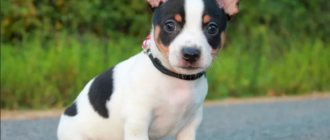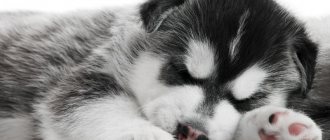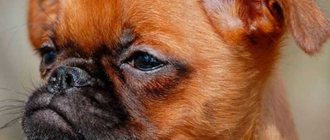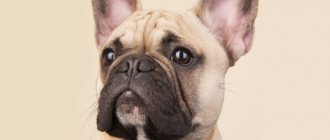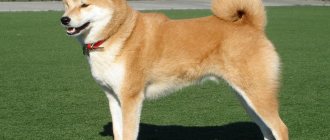Personality of the Spanish Greyhound
- Active
- Aristocratic
- Balanced
- Fearless
- Purposeful
- Wary
What conditions make up a dog's character? It is widely believed that the character of a four-legged pet is determined at the genetic level. Also, many people close to cynology argue that character traits are nothing more than the consequences of training and daily upbringing of a puppy. The conditions under which the pet is kept also play an important role. You should not expect your pet to be sociable and friendly towards people if he has been shouted at since childhood, waved at with a leash, or with a newspaper.
Experienced dog breeders will certainly say that if you want to achieve mutual understanding with your own pet, then you must match in temperament and in some character traits. To correctly choose the breed that suits you, first study this issue theoretically: consider the exterior of the dogs you like, read the breed standard, pay attention to the description of the temperament and characteristics of the breed's behavior, ask questions to the real owners of the breed you are interested in. If, in theory, you are satisfied with the breed of your future pet, go to a nursery, or to people engaged in private breeding. A competent breeder who cares about his breed will readily respond to your requests for help in selecting a puppy. It is difficult to say with certainty what kind of character your chosen dog will grow up to be in such a short period of time. There are several simple tests with which you can choose a little friend with the qualities you need.
General description of history
Spanish galgo shows a long, centuries-old history. From the name it is clear that the breed originated in Spain. This is a bright representative of the greyhound family. The breed was bred specifically for hunting. Galgo was used in hare hunting, but the hardy dog is not averse to hunting wild boar.
Why galgo? Previously, in the 6th century, the Gaul tribes, known from school history lessons, lived on the Iberian Peninsula. From the word the Gauls, renamed in the Spanish manner, named the amazingly kind and faithful greyhound Galgo. Translated from modern Spanish, “galgo” means “greyhound”.
No one knows for sure whether galgos are considered native dogs or introduced to the Iberian Peninsula. There is no doubt that Portuguese Greyhounds and Ibicenco Podencos took part in the formation of the breed. In the exterior of the galgo, features of the Arabian sluggi greyhounds, which the Moors may have brought to the peninsula, are noticeable. Then the breed rapidly changed. Some scientists talk about Portuguese greyhounds, the characteristics of the breed are quite noticeable in the galgo.
The Spanish Galgo is exceptionally loyal to its family. Always tries to show and express feelings. It’s impossible to even imagine that Galgo would offend family members. Moreover, it is a hunting dog.
Galgo will never stand behind his owner, asking for protection; on the contrary, he will protect the person and family with desperate dedication. A stately dog will always be able to repel an offender.
Purebred Spanish Galgos are bred in Spain and other countries. The breed is considered the pride of the country. Animals show amazing endurance and agility.
Spanish Greyhound: features of the breed
- They love active games, but are not fussy.
- Purposeful and fearless hunters.
- They get along well with all family members.
- They are not confrontational and rarely start fights with other dogs.
- By nature they are not trusting of strangers and even show aggression.
- Always ready to protect his master, but not suitable as a guard.
- In the absence of walks and active players, they can run away from the owner.
- Spanish Galcos need close contact with everyone in the household.
- They will feel comfortable in a private house where there is territory. do not get along well in an apartment.
Pastor Garafiano
The Pastor Garafiano is a breed of Spanish Shepherd from the Canary Islands and is considered an excellent guard dog. This breed of Spanish dog is known for its protective, loyal nature and its extremely smooth fur. It is also characterized by an elongated snout and pointed ears.
This is recognized by the partnershipón españwave Garafian Shepherd.
Pact body with half-closed ears and elongated muzzle.
No organization recognizes this, although a standard for this breed has been proposed to the Royal Spanish Canine Society (RSCE).
Light brown.
This is recognized by the RGKP.
/en/images/2/3/1/24_majorca_shepherd_dog_3132_23_600.Jpg "alt =" Spanish dog breeds - top 26 - 24. Majorca Pastor ">
Health
The Spanish Greyhound is a completely healthy breed of dog that is not predisposed to hereditary diseases. In addition, dysplasia of the hip and elbow joints is not typical for them.
Attention! Spanish Greyhounds are sensitive to anesthesia.
Preventative measures to protect your Spanish Greyhound puppy
- To keep your Spanish Greyhound puppy completely safe, you first need to minimize his contact with unfamiliar dogs, especially strays. Therefore, you should not let your dog off the leash, as in this case it will become impossible to control its behavior and communication with other dogs. Since a dog can easily become infected with distemper from simply touching the nose of a sick animal. This disease can be transmitted to a dog through sniffing. Your dog can become infected with trichophytosis from contact with the lichen-affected fur of a sick dog. Naturally, it is impossible to completely exclude a dog’s communication with other dogs, since it must be socialized. Therefore, try to find friends with dog lovers who look after their animals. By adhering to this rule, you can eliminate the risk of pathogen transmission by 80%.
- You should walk your dog in places where there are no landfills. Since garbage very often attracts rodents, which in turn are very often carriers of various infections. Gray rats are especially dangerous because they carry such a serious disease as leptospirosis.
- You should not allow your dog to sniff other people's feces, as they are a source of worms.
- Monitor the health of your Spanish Greyhound. Pay attention to even the most minor changes in his behavior. For example, your dog may appear lethargic, lose his appetite, or have a dry nose. Or you may notice that the dog begins to shed, and this has nothing to do with seasonal shedding. If hair loss becomes excessive, this is the first symptom indicating health problems in your pet. And only you can help him. Therefore, it is important to take the dog to the veterinary clinic in time, where the disease can be overcome for sure. In no case should you ignore the symptoms, since advanced infections are much more difficult to treat, and sometimes even impossible. If you start treating your dog, the disease can lead to his death or he will develop serious complications that will affect his hearing, vision, limbs and much more.
Appearance
Galgo is a tall, thin dog of a slightly elongated format with the outlines typical of greyhounds. Galgos are most similar to greyhounds, but they are leaner and give the impression of being smaller dogs than greyhounds.
The head of these dogs is elongated, very narrow, with a sharp nose. The length of the skull and nose are approximately the same. The transition from forehead to nose is smooth. A slight hump nose is allowed. The nose is small and always black. Lips are thin, dry, dark or black in color.
The eyes are almond-shaped, small, slightly slanted. Acceptable eye colors are all shades of brown. The eyelids are sweaty, have pronounced eyelashes, and are always painted black.
The ears are triangle-shaped with a wide base, semi-erect, usually laid back and pressed to the head. When a dog is in a state of excitement, the ears may stand up on their cartilages or stand up completely.
The neck is long, slender, flexible. The transition from head to neck is very smooth. Visually, the galgo's neck may appear somewhat thin, "swan-like".
The body is elongated, with a pronounced deep chest and a strongly tucked belly. The back is slightly arched, the withers are not pronounced.
The croup is elongated and sloping. According to the requirements of the standard, galgo must have a well-defined muscle profile.
The tail is set low, very long, thin, whip-like. When extended, the tail reaches the ground. When at rest, it hangs down, forming a slight bend.
The forelimbs are set at right angles to the body, while they themselves are almost straight. Pasterns short, very dry. The joints are not pronounced. The shoulder blade is strong and has a pronounced relief. The elbows fit tightly to the chest, while being able to move freely while running. The hind limbs are set parallel to each other, slightly set back. The thighs are very powerful, muscular, and wide. The angles of the hock joints are well defined, although the joint itself has a smooth transition. The paws are dry, tightly knit, with long arched toes and very strong claws.
The coat is short, very soft and fine, lying close to the body. The decorative hair is not developed. The standard also allows the presence of a wire-haired variety of dogs of this breed. In this case, the coat is slightly curly, short and does not adhere to the body.
Galgos are of any color, including piebald. Preference is given to bicolor with symmetrically located small white markings.
Training and education
Although Spanish Greyhounds are not usually the easiest dogs to train, their gentle nature allows them to be taught all the necessary commands. When given positive reinforcement, your Galgo will follow basic commands just fine.
Submitting a dog doesn't always work. The principle of complete submission of the Spanish greyhound to the owner is an outdated method. This theory was formulated based on observations of packs of wild wolves, but they were kept in captivity and, of course, experienced stress. The stress condition forced wolves to show aggression towards each other, but in the wild they do not show aggression to each other - they live together and interact with each other. You need to perceive yourself as the more experienced and mature member of the pack, who is responsible for guiding the new member (Spanish Greyhound puppy) and teaching him good behavior, as well as correcting him if necessary. It is important to remember that Spanish Greyhound puppies learn a lot on their own. They are very inquisitive, love to explore new territories and, of course, experiment. Puppies tend to repeat actions they enjoy (like playing with a toy). They do not repeat actions that cause them pain (for example, destroying a nest and getting bitten). If your Spanish Greyhound puppy misbehaves, ignore him and praise him when he does the right thing. Reward your puppy for following commands and good behavior. Do not neglect these tips. After all, constantly hearing “you can’t” all day long is unbearable. This is a small child who wants to know everything and get his portion of treats as a reward for not eating your favorite rug, going to the toilet outside, bringing you a ball, and so on.
Set rules and monitor their implementation
It is worth enrolling your Spanish Greyhound puppy in obedience training classes. These classes will allow you to understand exactly what actions will allow you to control your dog’s behavior. You will be able to spend more time with your puppy, establish contact and socialize around other dogs.
Adviсe
- Training a Spanish greyhound puppy should be done with the help of positive motivation; watch carefully special films about this technique. The Canine Translator film series from National Geographic is suitable.
- If you need to leave your puppy at home alone for 2 hours or more, then ask someone to come to him.
- Be sure to make an appointment with your Spanish Greyhound puppy to see your veterinarian as soon as possible. The doctor will carefully examine him and give him vaccinations that will protect him from dangerous diseases.
Nuances of care
This is a rather unpretentious pet, but the specifics of caring for it depend on the type of its fur coat. It is better to keep your pet in your own kennel.
He is not entirely comfortable in the apartment, because there is not enough space for him to play and keep in excellent shape. If you plan to keep it outside, make an insulated booth in which you can hide in frost or strong winds.
The smooth-haired variety requires regular supervision. Clean the body with a stiff comb, wipe as needed with a piece of damp cloth. Comb coarse hair with a comb, and bathe only if it is very dirty. Remove plaque from the ears once every 2 weeks, and shorten the claws by a couple of mm if they do not grind down naturally.
Where to buy a Spanish greyhound puppy?
A specialized kennel is the best place to buy a good Spanish greyhound puppy. If pedigree and thoroughbred are important, then it is better to hire an experienced dog breeder to help. If not, then you can trust your heart. On nursery websites, there are customer reviews that will help you navigate. A little secret or life hack: visit a dog show where the desired breed will be presented. Chat with the owners of the breed, ask about the nuances, find out where they purchased the puppies. True dog breeders live for their pets, so they will be happy to answer any question and give valuable advice. Typically, nurseries send their representatives to exhibitions, where there is a chance to meet in person and take a business card.
How to choose a strong and healthy Spanish greyhound puppy
The day has come to go to the nursery for a cute puppy. Babies should be kept in a clean enclosure, without a specific unpleasant odor, which is very important. First of all, the breeder will demonstrate the numerous awards that his pets have received. Listen carefully, but don’t be easily fooled by all the big titles and championship accolades. If possible, you need to look at the parents of the future pet. Top 10 signs that will help you choose a healthy Spanish Greyhound puppy:
- shiny and moist nose;
- clean ears, pink;
- lively, clear look;
- clean eyes, without any discharge;
- healthy skin, without parasites, sores and acne;
- silky, shiny coat;
- lymph nodes of normal size;
- tail without creases;
- no bloating.
A good proof that the animal is healthy is a written document of purchase and sale. If a Spanish greyhound puppy develops abnormalities over time, according to the contract, the pet can be returned. Having “insurance” with the buyer will reduce the risk that the seller will slip in a problem animal.
Age for adoption
- Professional Russian dog breeders advise buying 8-10 week old puppies. At this age, the baby should already be vaccinated, toilet trained, and receive basic education.
- An important point: it is not recommended to take a puppy home immediately after separation from its mother. Until 9 weeks of age, the baby learns dog language and learns to communicate with its own kind. He needs to spend several weeks in a doggy daycare.
- A professional breeder knows that a Spanish Greyhound puppy less than 6 weeks old should not be given away. A very small puppy can only be given to an experienced owner who knows how to raise it correctly. This option is not suitable for a beginner.
- Depending on the breed, the puppy can be picked up earlier or later than 10 weeks of age. Large dogs grow more slowly, so it is recommended to remove them from kennels at the age of 3 months. Puppies of such breeds should gradually build up bone and muscle tissue, without sudden jumps, in order to avoid problems with the musculoskeletal system.
- For Spanish greyhound puppies of show or breeding class, the age of “adoption” can only be 6-9 months. This is a mandatory condition, because it is at this age that the makings of a champion and the distinctive signs of thoroughbred are revealed. You need to have patience to get a future titled champion.
Note : even the most expensive Spanish greyhound puppy cannot be 100% guaranteed to become a champion. The breeder’s job is to assess the potential and make a forecast. Next, you need to raise the puppy and train it for a long time in order to realize the makings of a champion.
Documentation
- A Spanish Greyhound puppy has a mark in the groin area or it may be on the ear, as well as a puppy card (metric). The codes on the card and on the stamp must be identical.
- Metrica is the primary document that is issued for a puppy when it reaches the age of 45 days. Next, a qualified dog handler examines the babies and notes any defects found. The owner of the dog, if desired, can change the metric to a new document, pedigree, at the age of 6-15 months. This document will allow the pet to participate in breeding.
- Another document for the puppy is a veterinary passport, with mandatory vaccination and deworming notes.
How to properly care?
Caring for representatives of this breed is not difficult, the main thing is to accustom your pet to hygiene procedures from childhood and carry them out regularly.
Wool and bathing
You need to brush your dog with a metal brush 2-3 times a week, and daily during the shedding period.
After each walk, you need to wash your pet’s paws and belly, and give him a full bath no more than once a quarter, using a special shampoo that matches his coat type.
Claws
With regular and long walks, the Spanish Mastiff's claws grind down to the required length on their own. If this does not happen, they need to be trimmed with a nail clipper about 1-2 times a month, and the sharp edge should be filed with a nail file.
NOTE! If your pet has dewclaws, the claws on them must be shortened yourself, since they do not grind down.
Ears and eyes
Ears should be wiped once a week with a damp cloth to get rid of dirt and dust, and accumulated wax should be removed with a cotton swab.
The eyes should be examined for inflammation and increased lacrimation, and wiped with a cotton pad in the morning, removing any secretions that have accumulated overnight.
Interesting facts about Spanish galgo
- Today, galgos are popular in southern Europe, but are unknown outside this region.
- Spanish galgos are traditionally used for hunting medium and small game. In addition, recently they have begun to be used in hunting ungulates.
- Galgos are still used as hunters, among other things they participate in greyhound racing, specialized coursing competitions and hunting sporting events. This breed is bred as companion dogs.
If you decide to get a dog, then get ready for the following: you will often have to clean up little mistakes after your puppy; investments will be required in annual vaccinations, feeding, toys, ammunition, etc.; any animal requires attention and communication, so if you don’t have time, then there will be no mutual understanding with a Spanish greyhound puppy. Big changes are coming in your life. If you can handle this, you will find a loyal friend for life. The character of Spanish greyhounds: who is better to take a bitch or a dog?
Spanish Greyhound The character of the dog depends on heredity and breed characteristics, but proper upbringing and training is also of no small importance. In… Read more
Spanish Greyhound color
Spanish Greyhound Color is a canine term that refers to the color of a dog's coat. It is one of the most important signs when ... Read more
Training and education of Spanish greyhounds
Spanish Greyhound Raising a dog is about developing correct behavior. This is the basis for successful training. Training is a set of activities... Read more
Diseases of Spanish Greyhounds
Spanish Greyhound Each breed of dog has a predisposition to certain diseases. We have collected information about typical diseases of the breed. Remember the symptoms of the disease, ... Read more
Spanish Greyhound (Galgo)
A little history
Like most very ancient breeds, the stories about their origin seem quite vague, as they have a number of unconfirmed speculations passed off as known facts. History experts believe that the ancestors of modern Spanish bulldogs appeared in Spain, once called Iberia, along with the warring Alan tribes. These barbarians endlessly attacked and ravaged the western lands of the Roman Empire for almost two centuries, starting in the 4th century. Therefore, it is reasonable to assume that the name of the Alan breed comes precisely from the name of the Alan tribes.
In the first mention of the breed in the ancient “Book of Hunting,” written by the famous medieval writer Juan Manuel, a detailed description of the appearance and character of these dogs was given, which dates back to the 14th century and dates back to the reign of King Alfonso XI of Leon and Castile.

